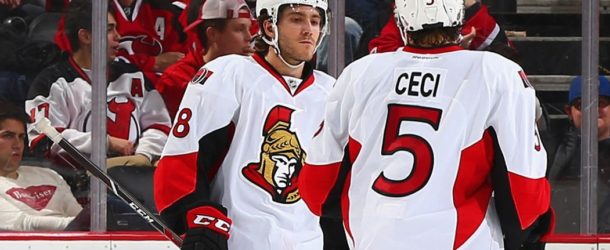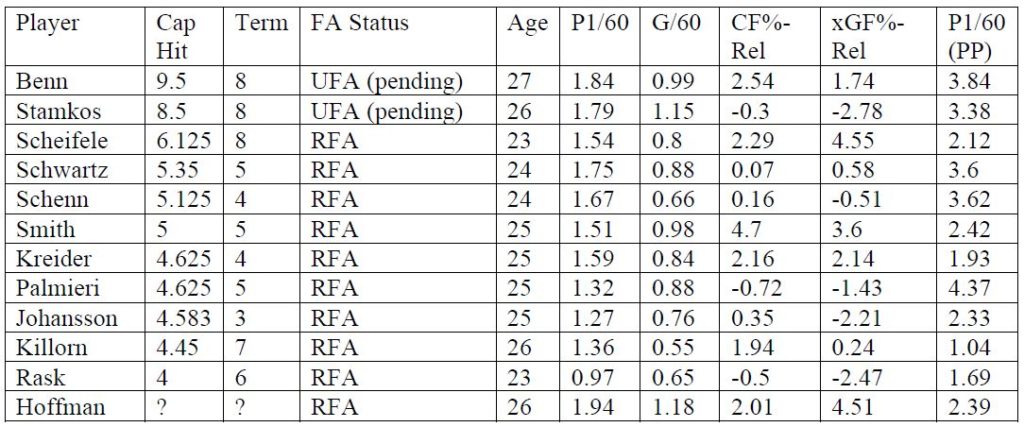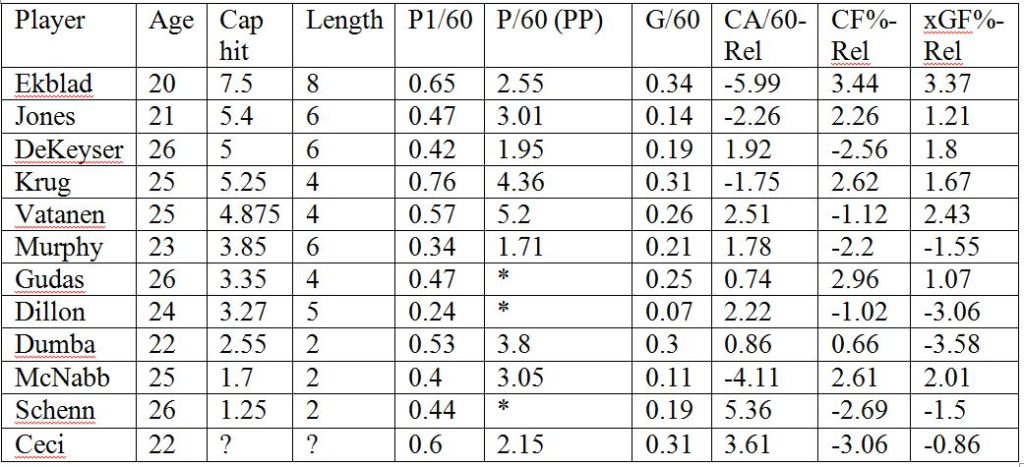WRITTEN BY SENSCHIRP READER- KarlssonFan
Hey SensChirp faithful,
KarlssonFan here again with an in-depth look at our 2 biggest RFAs, Hoffman and Ceci, and our shiny new toy, Brassard. We’re going to look at possible contract comparables for Hoffman and Ceci based on recent signings, as well as stats-based comparisons league-wide. With Brassard, we’re going to look at stats and comparable players from different time periods from his career, and talk about what we should expect from him this season and beyond. Without further ado, let’s jump in and take a look at Mike Hoffman:
EDIT: This Hoffman section was written before he signed his contract. I have left it as is, and added a section at the end discussing his actual contract.
He has lots of contract comparables. He’s 26 and is one year removed from UFA status. There have been several recent signings coming in at around $5M per season for players of his age. We’re also going to see how he compares to the 2 most high-profile forward signings from the past month: Benn and Stamkos. We’re going to only look at mid- to long-term signings (3-8 years), and we won’t look at anything below $4M per season because the talent level just wouldn’t make sense anymore. I tried to get a good variety of ages (23-27), terms (3-8 years), and cap hits ($4-9.5M).
The players I’ve chosen are as follows:
Jamie Benn, Steven Stamkos, Mark Scheifele, Jaden Schwartz, Brayden Schenn, Reilly Smith, Chris Kreider, Kyle Palmieri, Marcus Johansson, Alex Killorn, and Victor Rask. I’ve included their age and contract details in the chart below.
We aren’t going to look at as many stats as we have in previous posts, because I do have 3 separate players to analyse. For Hoffman comparables, we’re going to look at:
-primary points per 60 minutes of 5-v-5 play (primary assists+goals; P1/60)
-goals per 60 minutes of 5-v-5 play (G/60)
-primary points per 60 minutes of 5-v-4 play (P1/60 (PP))
-Corsi-For%, relative to teammates, at 5-v-5 (CF%-Rel)
-Expected Goals-For%, relative to teammates, at 5-v-5 (xGF%-Rel)
Expected Goals-For% (xGF%-Rel) is a new stat that I’ll briefly go over now. xGF% is the same as GF% (goals-for%) except it doesn’t track actual goals. Instead, it looks at shot frequency and shot quality (based on distance, angle, rebounds, etc) for and against and determines the expected goals for and against with player A on the ice. For example, if a player takes lots of low-quality shots but allows high-quality shots, this will be reflected in a negative xGF%. This tries to account for what bad possession teams call “picking your spots” or “keeping shots to the perimeter”. Some incredibly talented shooters (Stamkos, Ovechkin, etc) will vastly outperform their xGF% because they are more likely to score than, say, Chris Neil, from any given spot on the ice. However, negative numbers tend to mean that they allow a) too many shots against, or b) high quality shots against. Okay, now here’s the chart, from highest to lowest average annual value (AAV), or cap hit, of contract (all stats are from the past 2 seasons):
In terms of pure point production at 5-v-5, Hoffman is outstanding. He has the best P1/60 and G/60 of any of the players here, including Benn and Stamkos. His PP production is actually middle of the pack, right around Smith and Johansson. His CF%-Rel is in the second tier (after Smith) alongside Kreider and Killorn. His xGF%-Rel is outstanding, essentially tied for 1st with Scheifele, and well ahead of 3rd-place Smith.
Looking at Corsica’s similarity calculator using the following (equally-weighted) stats: G/60, P/60, Rel-CF%, Rel-GF%, Rel-xGF%: (Note: these are using career numbers since 2007 for all players. For example, these stats do not include Ovechkin’s stats from 2005-2007, and only include Mats Sundin’s stats from 2007-2009 when he retired.)
95%+: Tyler Seguin
93%+: Jamie Benn, Rick Nash, Corey Perry, Vladamir Tarasenko, Marian Gaborik, Alex Ovechkin, Alex Semin
90%+ Bobby Ryan Alex Radulov, David Pastrnak, Nikita Kucherov, James Neal, Jordan Eberle, Steven Stamkos, John Tavares, Mats Sundin, Evgeni Malkin, Tyler Toffoli, Jonathan Toews
That is some elite company. What I see in this list are elite offensive players, both young (Tarasenko, Pastrnak, Seguin) and older (Ovechkin, Nash, Gaborik). Given that his 5 closest career matches are Seguin, Benn, Nash, Perry, and Tarasenko, I think it’s safe to say that Hoffman is a bona fide top-line scoring winger. He has developed into that high-skill, high-speed forward that we always want to draft.
Now that we’ve decided that Hoffman is an elite point-producer and an excellent possession-driver, we need to look at his potential contract. Based on the chart above, Hoffman should be worth more than basically everyone except Benn (I think Stamkos is overrated, and I didn’t think he’d be worth whatever contract he signed. Tampa was lucky to get him at $8.5M, because $10M+ would have been an overpayment for sure). Obviously, Hoffman isn’t getting $9M. People may want to chime in and talk about his defense, but when adding defensive stats like CA/60-Rel (essentially, limiting shots relative to team), GA/60-Rel (limiting goals relative to team), xGA/60-Rel (expected goals against relative to team), and iGVA/60 (individual giveaways per 60), his 92%+ comparables are Stone, Seguin, Wojtek Wolski, Kopitar, Perry, Ryan, Voracek, and Benn (in descending order). That is, again, very good company. Adding guys like Stone, Kopitar, and Voracek when including defensive stats can only be good news.
To be honest, it’s probably a very good thing that Ottawa’s powerplay has been less than stellar (or just hasn’t included Hoffman) over the past 2 seasons. While 5-v-5 points are clearly more important in terms of winning games, the reality is that straight goals and points stats are probably the #1 and #2 things that determine contracts. If Hoffman had added 5g/5a on the powerplay in each of the past 2 seasons (especially his rookie season, when he only got 3 PPP), we’d be talking about Hoffman asking for $7M and the Sens countering with $5.5M. With increased PP success, Hoffman can probably hit 35g/35a this coming season, especially if he plays with a healthy Turris-Stone combo.
Anyway, back to the contract: his closest comparables (other than Benn) are Schwartz and Smith, who are 24 and 25, respectively. They both signed for 5 years, at $5.35M and $5M, respectively. Given Hoffman’s numbers, he’s likely worth slightly more than either of them, at least in the short term. 5 years at $5.5M seems reasonable. If the Sens want to keep the cap hit lower, they’d probably have to offer 6 years at $5.25M, and if they want to keep term lower, maybe 4 years at $5.75M (which only buys 3 years of UFA status). Of course, in reality, based on his numbers, he is likely worth $6+M per season for at least the next 2-3 years, but I can’t see his contract starting with anything other than a “5” if it’s mid- to long-term.
What are the best- and worst-case scenarios? In a perfect world, I would sign Hoffman for 4 years, and would not go longer than 5. Although he is incredibly talented, much of his game is based on speed, which diminishes the longer you play hockey. Past age 30, I wouldn’t trust his legs to keep his game at such a high level. The only (and I mean ONLY) way I would consider a 6-year deal is if the cap hit started with “4”, but I don’t think that’s good for either party. If the Sens can swing a deal for 4 years at $5.25M, that would be FANTASTIC. 5 years at $5.75M would be the highest I’d feel comfortable going. I don’t think a number that high is going to fly with management/Melnyk, though. My prediction is something in the middle: 5 years at $5.5M, which I think is totally reasonable. Like I said, though, 4 years would be my preference.
Flash-Forward:
Alright, so now Hoffman has signed his contract: 4 years at $5.1875M. I mentioned above that 4 years at $5.25M would be an amazing, best-case-scenario deal, and somehow Dorion did better. Let me very clear here: this deal is 100% a win for the Senators. 100%. 5-v-5 production is underrated for some reason, and he (along with guys like Taylor Hall) is undervalued due to his lack of overall goals/points due to lack of PPP. This is a tremendous steal for the Sens, and every single fan should have jumped up with excitement when they heard about the contract. I’m predicting an improved powerplay with Hoffman on the first unit under new coach Guy Boucher, and 70 points for the speedy left-winger. The greatest thing about this? Hoffman is the second-best forward on the Sens, and Stone’s contributions will likely be just as overshadowed as Hoffman’s were. Stone probably won’t get paid the $6M he deserves either, barring a huge uptick in point production to the 75-point range (which, actually, is not out of the question).
I cannot stress enough how fantastic this deal is for the Senators. If trading Zibanejad for Brassard allowed this deal to happen with Hoffman, then I am fine with the trade, because Hoffman is very likely better today than Zibanejad will ever be. I’m sure I’ll take some heat for that comment, but I don’t see Zibanejad ever cracking 65 points or being a star #1C.
To wrap up this section: Hoffman is awesome, and I’m thrilled to have him in a Sens jersey for the next 4 years, especially at such a great price point.
Onto the next order of business: Cody Ceci.
I’m not sure there is a more polarizing player on the Sens roster right now. Ryan, Lazar, and Phaneuf might come close, but there is quite a divide in the fan base regarding the young defenseman. His decent point numbers coupled with his age and draft pedigree have many fans hoping that he continues to improve and become a real top-4 D, while many “stats people” are worried by his underwhelming possession numbers. Let’s take a look at him and his comparables, although there are fewer of them compared to Hoffman, and there are more variables at play for young defensemen. Because Ceci is so young, there are not many players who signed their second contracts at a comparable age (22). The ones who did are usually future superstars. As a result, most of the players here are older than Ceci. All players were RFAs except Schenn.
I’m still mad that Ekblad beat out Stone for the Calder, but man, he is a freak of nature. 20 years old and he is a legitimate, dominating top-pairing D. Might be the 2nd-most valuable trade chip in the league after McDavid. Poor Buffalo, losing out on both of those players…Anyway, back to Ceci. Where Ceci excels is in point production. And it’s a good thing he gets points, because he has terrible possession stats. In this group, he is near the top in both G/60 and P1/60 at 5-v-5, and his PP production has not been very good (players with a * have not played 50 total minutes on the PP in the last 2 years; numbers were not included). Of course, he rarely sees time with Ottawa’s best players, so there’s room to grow there, especially with an improved PP system. From a possession standpoint, Ceci has the worst shot suppression and overall possession numbers out of the players in that chart. However, his expected goals for percent is not horrible; that is a good sign (good relative to his possession numbers; -0.86 is obviously not “good”).
Again using Corsica’s similarity calculator, Ceci’s notable (i.e. in the league longer than 2 years) comparables were Slava Voynov, Trevor Daley, Roman Josi, Zach Bogosian, Justin Schultz, Brent Seabrook, Matt Irwin, and Michael Del Zotto. You may look at that list and point to top-4 or even top-2 defensemen, but unfortunately these are not fantastic players. Josi, while an excellent point producer, has 0 capacity to limit shots against (quite literally twice as bad as Ceci in that department). Seabrook is incredibly overrated because he is “tough” and “a winner” etc. Daley and Bogosian are serviceable 2nd-pairing options, but not players that 15th-overall picks should aspire to become. That may be Ceci’s ceiling, but there’s nothing wrong with being a solid #4D in the NHL.
The most comparable players on the above chart are Murphy and Dumba. They are the same age (Murphy is 23, Dumba is 22), and have been less-than-stellar possession players. Dumba excels on the PP but is slightly less productive at even strength than Ceci; Murphy lags well behind overall. Despite the best possession numbers of the 3 players, Dumba has an oddly low xGF%; it seems as though the Wild take low-percentage shots and allow high-danger opportunities while Dumba is on the ice. Overall, I’d say Murphy is the worst of the 3, and Dumba and Ceci are about comparable. I think the Murphy contract was pretty bad, because there’s no reason to lock him up that long given his low production thus far in his career. Dumba’s contract seems fair, and I’d expect Ceci’s contract to look about the same: 2 years at $2.5M. Ceci is the perfect player to give a bridge contract to, because he has potential but has not shown it yet; a long-term deal now is much too risky, and a 1-year deal just doesn’t make much sense. He’ll still be an RFA after 2 years, so that seems like the way to go.
In conclusion, Ceci is not a very good player at this stage in his career, and would be better off as a #5D getting sheltered minutes alongside a good shot-suppressing partner. Unfortunately, given the current state of our defense corps, that’s just not going to happen. Hopefully after his next contract (which, again, is likely to be 2 years), he will have solidified himself as a serviceable top-4 option.
And finally, our last section: Derick Brassard
We’re going to look at stats for 3 lengths of time: his whole career, the past 4 seasons, and the past 2 seasons. I’ll also list the closest notable comparables for each time period.
2007-2016: For his career, Brassard has been a positive possession player who doesn’t seem to allow high-quality chances, and consistently outperforms his xGF%-Rel. He produces points at a decent clip as well. Overall, he seems like a good top-6 C. His comparables are solid players, most of whom were top-6 fixtures for many years.
Notable comparables: Maroon, Doan, Oshie, Backes, Jokinen, Hagelin, Hemsky, Whitney, Okposo, Stepan, Roy
2012-2016: For the past 4 seasons, Brassard has outperformed his good career numbers in every category except A/60 (which decreased marginally). He showed no sign of decline as he entered his late 20s around 2013. This is good news when trying to project his aging curve. Most players have their most productive seasons around 23-26 and begin their decline around 27 (assuming they’ve been in the league for a while). Brassard seems to be hanging on longer than average. These comparables are actually better than his career ones; better possession players and better point producers as well.
Notable comparables: Hagelin, Little, Okposo, Whitney, Doan, Jokinen, Hartnell, MacArthur, Eriksson, Perron, Stepan, Hemsky, Pouliot, Havlat
2014-2016: For the past 2 seasons, Brassard bucked the trend and actually increased his numbers in every category shown above. This is, again, good news for Sens fans. If he can hold on and stave off his decline until after the 3 years are up on his contract, he might work out very well in a Sens uniform. Of course, he had an abnormally high shooting% last season, and these excellent numbers are mostly driven by a fantastic 2014-2015 season, but if he can rebound even slightly and keep it up, we’re in business. Of course, the flip side is that his last season was not that great and it might be the start of his decline, but I’m optimistic. Once again, the comparables got better, adding Zetterberg and a trio of excellent young players in Gaudreau, Schwartz, and Nyqvist.
Notable comparables: Eriksson, Zetterberg, Okposo, Havlat, McDonald, Hemsky, Frolov, Jokinen, Kevin Hayes, Gaudreau, Schwartz, Nyqvist
Overall, I think we’ll be pleased with Brassard the player, and New Yorkers have only good things to say about Brassard the person, Brassard the teammate, etc.
Final Notes:
I am pretty okay with the Zibanejad trade for several reasons:
-I don’t think he will ever reach the level others think he will (i.e. 70-point #1C
-It allowed Hoffman to be signed to a fantastic contract
-Brassard is a very good hockey player who should jump-start our $7M man, Bobby Ryan, as well as our powerplay
I have literally nothing bad to say about Hoffman or the contract that the Sens signed him to. Pure gold. I really hope Ceci becomes a top-4 D this season because the Sens really need that to happen. Assuming MacArthur is healthy, I want to see this to start the season:
Hoffman-Turris-Stone
MacArthur-Brassard-Ryan
I think that’s better than MTR/HBS (although obviously I have no evidence for that). But HST is sweet, and I think MacArthur (possession man) will be a great complement to Brassard/Ryan, assuming they find some chemistry. I am assuming Ceci signs for 2 seasons, and if the total number is $5M or less I’m fine with it. I wouldn’t go above that though. And I definitely wouldn’t go long-term, yet.
Predictions for the upcoming season:
Hoffman: 71 points (34 goals, 20 PPP, excellent possession numbers
Ceci: 28 points (9 goals, 7 PPP, between -1% and 0% relative possession numbers (a big improvement, but still not amazing)
Brassard: 57 points (21 goals, 21 PPP, above-average, but not excellent, possession numbers)
Alright Sens fans, thanks for reading and hopefully we’ll get some more exciting offseason news sometime soon!
KarlssonFan





